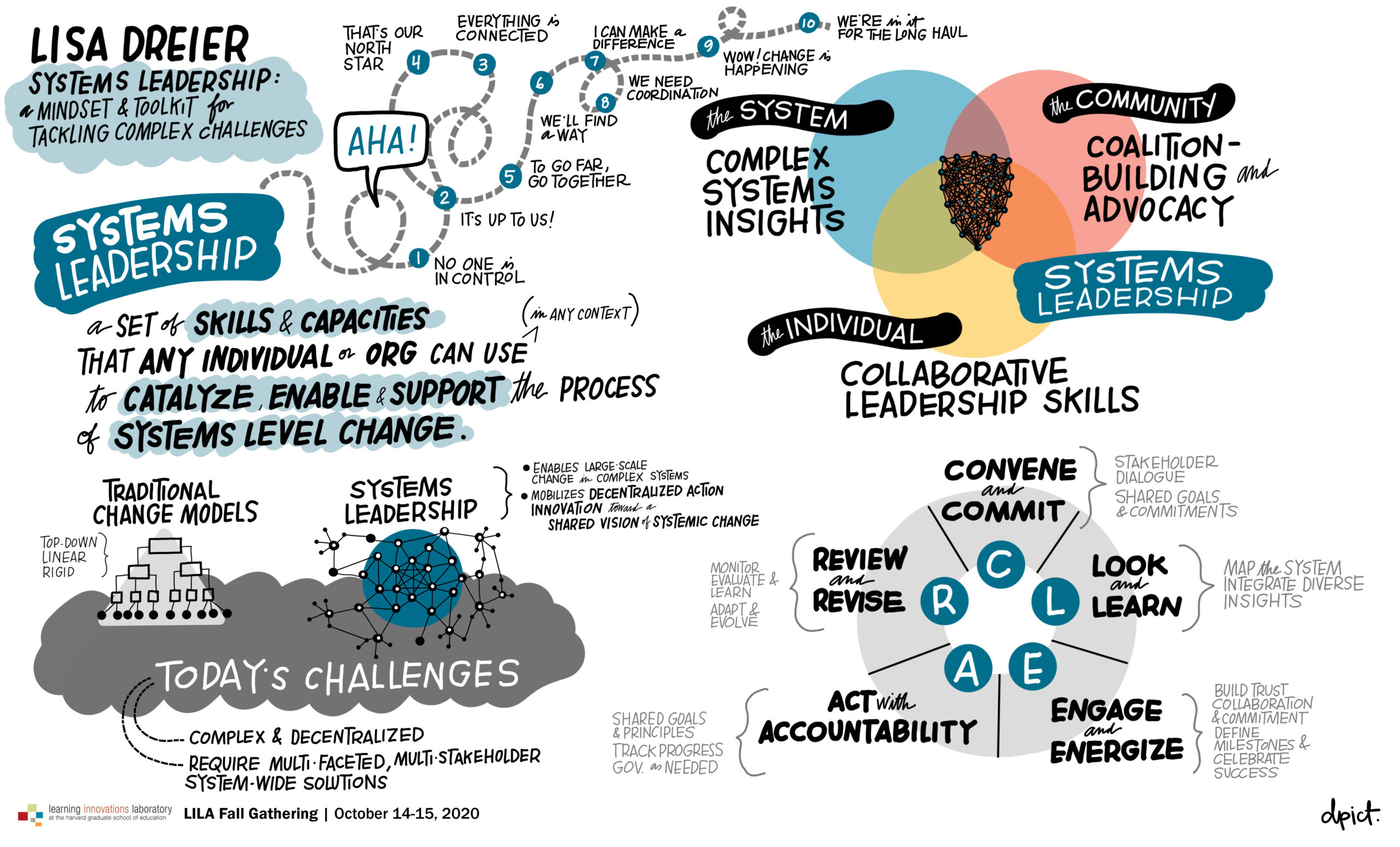During the October 2020 gathering, Lisa Dreier (Harvard) shared her work leading systemic change and the models that emerged from her work.

System leadership is about catalyzing change by bringing people together in collective, distributed leadership, particularly when no one entity is in control (Dreier, et al., 2019; Senge, et al, 2015). While formal authority and positions do matter, system leadership can come from anywhere in the organization: from above, below, and outside of these traditional structures of formal leadership. (Boylan, 2013; Senge, et al, 2015; Drier, et al, 2019). System leaders need not hold positional power – they can come from different leadership styles, backgrounds, positions, or approaches (Senge, et al., 2015). They also do not need to have all the answers. System leadership is about seeing the system more clearly, and creating conditions that enable others to practice and exercise leadership; it’s about collectively figuring out what the problem is, who should be engaged, and how you can begin to take action in new ways (Dreier et al., 2019; Ganz, 2008; Heifetz & Linsky, 2002; Senge, et al., 2015; Walker, 2016).
What is Systems Leadership?
Systems Leadership is both a mindset and skillset for tackling complex challenges—capacities that any individual or organization can use to catalyze, enable, and support the process of systems-level change. Unlike traditional top-down approaches to problem solving, systems leadership is a set of tactics that can be applied in multiple contexts. They can be initiated by anyone at any level in an organization and applied to any issue on any scale.
Why Should We Utilize Systems Leadership?
Traditional approaches to mobilizing have been top down, rigid, and structured, which works perfectly well when trying to solve a problem within the domain of control of one organization (for example, a company changing their supply chain). These methods don’t work for tackling large- scale, complex, dynamic problems, so Systems Leadership is utilized to mobilize change around a shared agenda beyond structures of formal authority and hierarchy. This shared agenda is generated through the collaboration of many diverse stakeholders, built upon trust, as they work towards creating change and making progress on an issue that affects them all.
3 Key Elements of Systems Leadership
System Leadership focuses on the roles of the individual, the community, and the system, and on how they intersect. Guest Faculty Lisa Dreier and her colleagues (2019, p. 4) outline these three roles clearly:
The Individual: The skills of collaborative leadership to enable learning, trust-building, and empowered action among stakeholders who share a common goal
The Community: The tactics of coalition building and advocacy to develop alignment and mobilize action among stakeholders in the system, both within and between organizations
The System: An understanding of the complex systems shaping the challenge(s) to be addressed
Dreier et al. (2019) offer a framework for leading system change called the CLEAR Framework (p. 4). It describes five key elements of the system change process, which are likely to overlap and repeat in a cyclical fashion during a change initiative.
- Convene and Commit: Key stakeholders engage in moderated dialogue to address a complex issue of mutual concern. They define shared interests and goals, and commit to working together in new ways to create systemic change.
- Look and Learn: Through system mapping, stakeholders jointly build a shared understanding of the components, actors, dynamics, and influences that create the system and its current outcomes, generating new insights and ideas.
- Engage and Energize: Diverse stakeholders are engaged through continuous communication to build trust, commitment, innovation, and collaboration. Inspiration, incentives, and milestones help drive progress and maintain momentum.
- Act with Accountability: Shared goals and principles set the direction of the initiative, while measurement frameworks help track progress. Coordination and governance structures can be developed as initiatives mature.
- Review and Revise: Stakeholders review progress regularly and adapt the initiative strategy accordingly. Adopting an agile, flexible, innovative and learning-centered approach allows for evolution and experimentation.
The System Leadership Journey: The “Aha! Moments”
Stakeholders across institutions and organizations realized that they had to be comfortable with the idea of no one person being in control or having authority over the entire system. Instead, they recognized their collective responsibility in mapping the moving parts in order to identify a “North Star”—a shared goal or high-level vision to guide and align efforts. They engaged buy-in from this wide array of stakeholders and recognized how challenges and setbacks tested the commitment and integrity of group—in fact, they spurred innovation, collaboration. The shift from unstructured and informal was needed to coordinate a “Secretariat” role in order to create sustainability and long-lasting structure for initiative. It was also important to measure and celebrate impact and progress to maintain morale and momentum.
How do you bring people together for that initial first step?
An organization needs to identify an individual for the role of the neutral and trusted convener, which is crucial for the first step in sparking the momentum. This person is responsible for sparking a collective recognition and/or a call-to-action can also alert a group of stakeholders that there is a request to work towards a common issue.

Add a comment